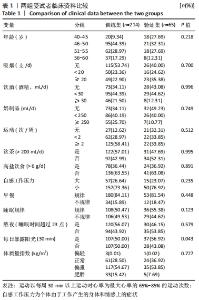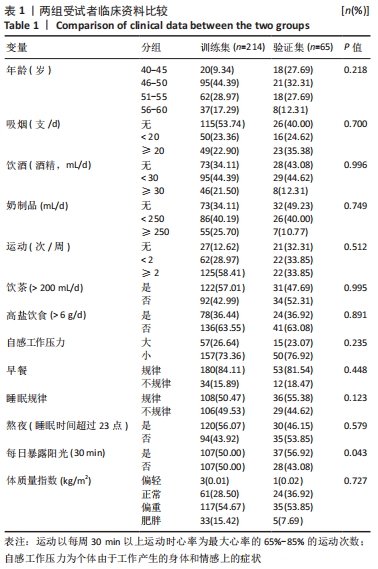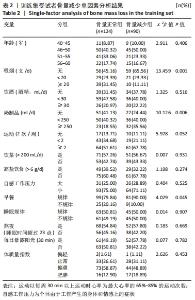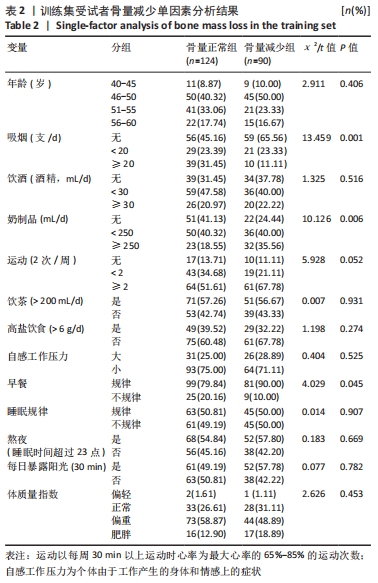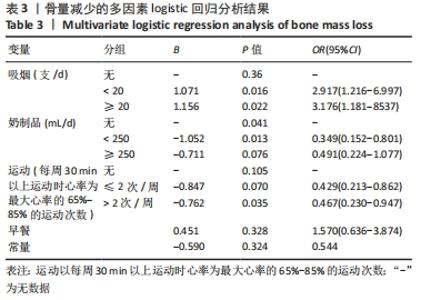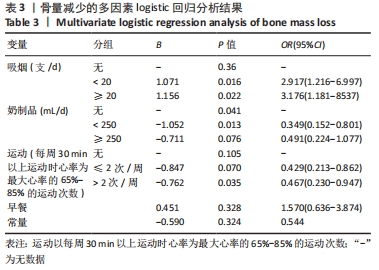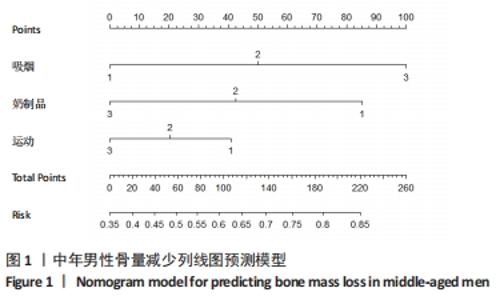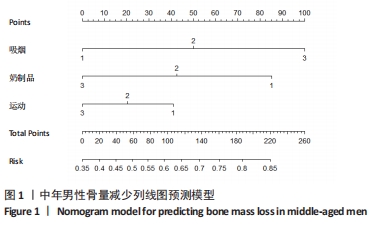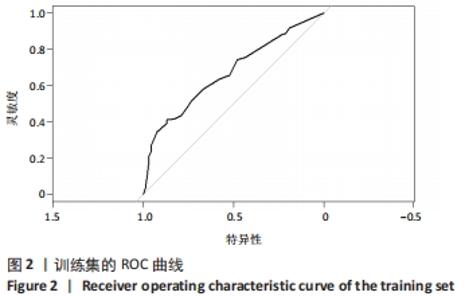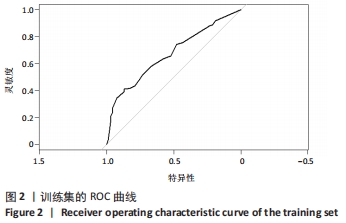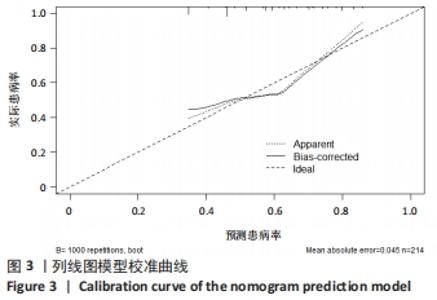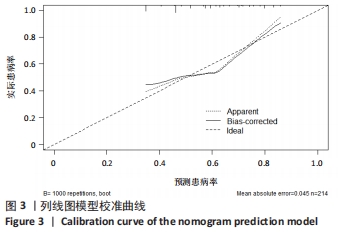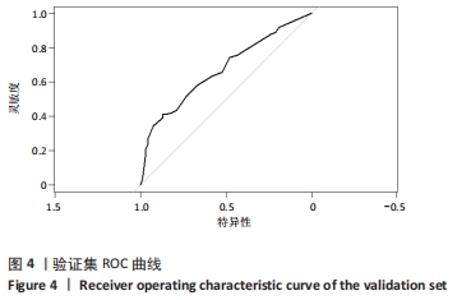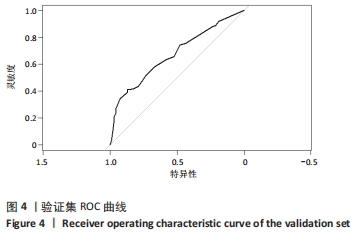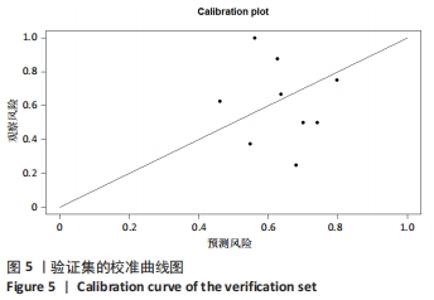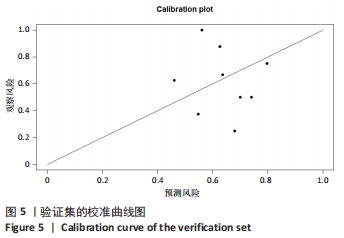[1] ZENG Q, LI N, WANG Q, et al.The Prevalence of Osteoporosis in China, a Nationwide, Multicenter DXA Survey. J Bone Miner Res. 2019;34(10): 1789-1797.
[2] 中华医学会骨质疏松和骨矿盐疾病分会. 中国骨质疏松症流行病学调查及“健康骨骼” 专项行动结果发布[J]. 中华骨质疏松和骨矿盐疾病杂志,2019,12(4):317-318.
[3] HAN HY, FENG S, QIANG H, et al. Nomogram to predict anastomotic leakage after laparoscopic anterior resection with intracorporeal rectal transection and double-stapling technique anastomosis for rectal cancer.Hepatogastroenterology. 2014;61(133):1257-1261.
[4] PARK SY.Nomogram: an analogue tool to deliver digital knowledge.J Thorac Cardiovasc Surg. 2018;155(4):1793.
[5] MINAEVA O, RIESE H, LAMERS F, et al. Screening for depression in daily life: Development and external validation of a prediction model based on actigraphy and experience sampling (Preprint). J Med Internet Res. 2020;22(12):e22634.
[6] vAN SMEDEN M, MOONS KG, DE GROOT JA, et al. Sample size for binary logistic prediction models: Beyond events per variable criteria. tat Methods Med Res. 2019;28(8):2455-2474.
[7] 周红坚.“骨质疏松症”规范化治疗——中国原发性骨质疏松诊治指南(2017)解读[A].云南省临床内科诊疗进展学习班暨玉溪市医学会第六届第四次内科年会资料汇编[C];玉溪:2017.
[8] 秦永生,张敏,郝占国,等.运动训练与心率变化[J].中国临床康复, 2003,7(6):952-953.
[9] 几点睡算熬夜?掉多少算脱发……8个知识一次说清![J].计量与测试技术,2020,47(9):117-121.
[10] 石林.工作压力的研究现状与方向[J].心理科学,2003,26(3):494-497.
[11] JUTBERGER H, LORENTZON M, BARRETT-CONNOR E, et al. Smoking Predicts Incident Fractures in Elderly Men: Mr OS Sweden.J Bone Miner Res. 2010;25(5):1010-1016.
[12] RUDÄNG R, DARELID A, NILSSON M, et al. Smoking is associated with impaired bone mass development in young adult men: a 5-year longitudinal study.J Bone Miner Res. 2012;27(10):2189-2197.
[13] QIN Y, LIU Y, JIANG Y, et al. Cigarette Smoke Exposure Inhibits Osteoclast Apoptosis via the mtROS Pathway. J Dent Res. 2021;100(12):1378-1386.
[14] ASPERA-WERZ RH, CHEN T, EHNERT S, et al. Cigarette Smoke Induces the Risk of Metabolic Bone Diseases: Transforming Growth Factor Beta Signaling Impairment via Dysfunctional Primary Cilia Affects Migration, Proliferation, and Differentiation of Human Mesenchymal Stem Cells.Int J Mol Sci. 2019;20(12):2915.
[15] 杨彪,黄碧.男性吸烟烟龄和吸烟量与骨密度关系[J].实用预防医学,2010,17(12):2464-2466.
[16] CHO IY, CHO MH, LEE K, et al. Effects of smoking habit change on hospitalized fractures: a retrospective cohort study in a male population. Arch Osteoporos. 2020;15(1):29.
[17] LOFMAN O, MAGNUSSON P, TOSS G, et al. Common biochemical markers of bone turnover predict future bone loss: A 5-year follow-up study. Clinica Chimica Acta. 2005;356(1-2):67-75.
[18] 陈小香,谭新,邓伟民.骨质疏松症患者骨密度与血清25羟维生素D的相关性研究[J].中国骨质疏松杂志,2017,23(7):851-855.
[19] 赵亮,冯佩明,黄敬.牛奶与钙剂对老年人骨密度作用的8年临床观察[J].中国骨质疏松杂志,2009,15(7):528-531.
[20] VAN DEN HEUVEL EGHM, STEIJNS JMJM.Dairy products and bone health: how strong is the scientific evidence?. Nutr Res Rev. 2018;31(2): 164-178.
[21] 陈伟,闫宁环,钱文涛,等. 添加牛奶碱性蛋白牛奶对大鼠骨密度的影响[J]. 中国乳品工业,2011,39(7):15-17.
[22] 周琦,周建烈.维生素D在补钙预防骨质疏松临床应用中的价值[J].中国骨质疏松杂志,2006,12(4):405-408.
[23] 钱素凤,祝鲁丹, 边平达,等. 老年男性服用复方钙剂与骨密度和骨代谢标志物的关系[J]. 浙江医学,2018,40(2):145-147+151.
[24] Roberto F, Giulia N, Manuela C. Dietary Patterns in Relation to Low Bone Mineral Density and Fracture Risk: A Systematic Review and Meta-Analysis. Adv Nutr. 2019;10(2):219-236.
[25] 温晓阳,周瑜斌.强骨胶囊联合钙剂对老年性骨质疏松患者骨密度及生活质量的影响[J].中国老年学杂志,2015,35(23):6884-6885.
[26] 袁辉辉,楼慧玲,陈巧聪,等.广州地区老年人维生素D与骨密度、甲状旁腺激素的相关性研究[J].广州医药,2018,49(4):20-23.
[27] GIANGREGORIO LM, PAPAIOANNOU A, MACINTYRE NJ, et al. Too Fit To Fracture: exercise recommendations for individuals with osteoporosis or osteoporotic vertebral fracture. Osteoporos Int. 2014;25(3):821-835.
[28] GÓMEZ-CABELLO A, ARA I, GONZÁLEZ-AGÜERO A, et al. Effects of Training on Bone Mass in Older Adults: a systematic review. Sports Med. 2012;42(4):301-325.
[29] 吴隽旎,陈熙,邹军.运动训练对儿童青少年骨代谢影响研究进展[J]. 中国运动医学杂志,2015,34(11):1121-1125.
[30] 董宏,孟良,王荣辉. 体育锻炼对中老年人群骨密度影响的meta分析[J]. 北京体育大学学报,2016,39(3):58-65+87.
[31] 陈亚丽,宋连新.老年骨质疏松患者的知识、自我管理和生活质量现况[J]. 中国老年学杂志,2012,32(22):4972-4974.
[32] 闫巧珍.不同时长有氧运动对老年骨质疏松患者骨密度的影响[J]. 中国老年学杂志,2017,37(13):3316-3317.
[33] American College of Sports Medicine. American College of Sports Medicine position stand. Progression models in resistance training for healthy adults. Med Sci Sports Exerc. 2009;41:687-708.
[34] RAMÍREZ-VILLADA JF, LEÓN-ARIZA HH, ARGÜELLO-GUTIÉRREZ YP, et al. Effect of high impact movements on body composition, strength and bone mineral density on women over 60 years. Rev Esp Geriatr Gerontol. 2016;51(2):68-74.
[35] BOLAM KA, UFFELEN J, TAAFFE DR. The effect of physical exercise on bone density in middle-aged and older men: A systematic review. Osteoporos Int. 2013;24(11):2749-2762.
[36] 陈金鳌,杨帆,陆阿明.长期力量训练后老年人骨密度变化特征[J]. 北京体育大学学报,2013,36(7):74-78.
[37] 王银晖.振动训练和传统力量训练对60-75岁人群骨密度影响的对比研究[J]. 中国骨质疏松杂志,2018,24(4):448-453.
[38] ANNE-BIRGITTE B, ANNETTE DT, DAWN TM, et al. The effect of glucocorticoids on bone mineral density in patients with rheumatoid arthritis: A systematic review and meta-analysis of randomized, controlled trials. Bone. 2018;114:172-180.
[39] 裘轶超.产妇盆底功能障碍列线图预测模型的构建[J].中国妇幼健康研究,2021,32(5):724-729.
[40] Iasonos A, Schrag D, Raj GV, et al. How to build and interpret a nomogram for cancer prognosis. J Clin Oncol. 2008;26(8):1364-1370.
[41] 贾玉龙,周洁,陈颖,等. 临床预测模型的综合评价体系研究[J]. 中国卫生统计,2019,36(5):728-730.
[42] 谷鸿秋,周支瑞,章仲恒,等.临床预测模型:基本概念、应用场景及研究思路[J]. 中国循证心血管医学杂志,2018,10(12):1454-1456.
[43] ZHAO Z, WICKERSHAM N, KANGELARIS KN, et al. External validation of a biomarker and clinical prediction model for hospital mortality in acute respiratory distress syndrome. Intensive Care Med. 2017;43(8): 1123-1131.
[44] Janssens ACJW, Martens FK.Reflection on modern methods: Revisiting the area under the ROC Curve.Int J Epidemiol. 2020;49(4):1397-1403.
[45] 谷鸿秋,王俊峰,章仲恒,等.临床预测模型:模型的建立[J].中国循证心血管医学杂志,2019,11(1):14-16,23.
[46] 文玲子,王俊峰,谷鸿秋.临床预测模型:新预测因子的预测增量值[J]. 中国循证心血管医学杂志,2020,12(6):655-659.
[47] 王俊峰,章仲恒,周支瑞,等. 临床预测模型:模型的验证[J]. 中国循证心血管医学杂志,2019,11(2):141-144.
[48] 李秋萍,谷鸿秋,王俊峰.临床预测模型:TRIPOD报告规范解读——以心血管疾病预测模型QRISK3为例(下)[J].中国循证心血管医学杂志,2020,12(8):904-907.
[49] 李秋萍,谷鸿秋,王俊峰.临床预测模型:TRIPOD报告规范解读——以心血管疾病预测模型QRISK3为例(上)[J].中国循证心血管医学杂志,2020,12(7):778-782+793.
[50] 孙铃,毛丽鹏,邹艾霖, 等. 急性心肌梗死患者住院期间恶性室性心律失常风险临床预测模型的构建与验证[J]. 中华危重病急救医学,2021,33(4):348-442.
|
